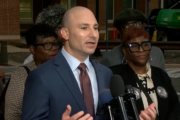Like many other students at large schools with competitive athletic teams, Alex Nash spent time in college attending sporting events.
But he wasn’t just a normal spectator. For every home game — in addition to some away games and tournaments — Nash, along with four other students, put on a maroon and gold costume and “devilish” persona to play Sparky the Sun Devil, the mascot of Arizona State University.
“Outside of the suit, I wasn’t very outgoing or showed a lot of emotion,” he says. “But then inside the suit you kind of flip a switch and turn it on and just become the character.”
Earning a spot as Sparky was no easy feat. For students interested in becoming a college mascot, here’s what to know about the tryout process, time commitment and rules to follow in the suit.
Tryout and Training Process for Mascots
Mascot tryouts vary per school, but the process can be competitive and may require students to fill out an application, take part in a formal interview to discuss related work experience and engage in performances and skits. Sometimes students are fighting for one spot, while in other cases students compete to be one of several or as many as a dozen who put on the mascot costume.
“A lot of people want to feel really involved in something and maybe they haven’t found the right club or the right thing,” says Christy Creson, director of spirit programs and events at Wake Forest University in North Carolina. “But they love coming to games and have huge school spirit. They really just want to be more involved but don’t know quite where they fit yet. And I feel like being a mascot sometimes is a great fit for that because one, no one is going to know who you are, so you get to go and be your best silly self. But you also get to be the biggest fan on game day and show your school pride in the biggest way possible by representing that school’s brand.”
Nash grew up attending ASU games. Despite being scared of mascots as a kid, he took an opportunity to be his high school’s mascot for two years. That eventually inspired him to try out for the role of Sparky during his freshman year of college. Not only was being a mascot a fun experience, it also sparked his interest in athletics administration.
“I used mascotting to get to know the athletic communication staff. That’s the field that I actually got into,” says Nash, who is director of social media at USA Baseball, the national governing body for organized baseball. “And I used my role as a mascot to kind of meet those people and get in that way. And that’s still what I’m doing to this day.”
[READ: Name, Image, Likeness: What College Athletes Should Know About NCAA Rules.]
At the University of Wisconsin–Madison, a team of six to eight students embody Bucky Badger. Tryouts occur each spring, with preliminary rounds consisting of four stations: role-playing, props, rhythm, and pushups and elevator stunts. Finalists have to show off their ice-skating abilities — since Wisconsin has an ice hockey team — perform a two-minute skit with music, props and costumes, and participate in an interview with a panel of judges, says Josette Jaucian, director of the school’s spirit squad.
“People may not think if them as athletes, but they train hard to be a mascot,” she wrote in an email. “Plus they have to be able to manage schedules, be reliable and communicate well.”
Being a mascot can be physically demanding. Some have to endure extreme heat, run onto the field with the team or do pushups after every touchdown during a football game — so training may involve strength-building and cardio, as well as a focus on hydration.
However, being a college mascot goes beyond being physically fit and sometimes meeting certain height requirements. Students also need to learn the persona of the character, including how the mascot walks, communicates without talking and poses for pictures.
“You have to convey excitement feelings only with your movements,” says Jason Namanny, associate athletic director of marketing and creative services at Tulane University in New Orleans. “Being overly animated when you are in the suit goes a long way.”
To be eligible for tryouts, students often have to meet certain GPA requirements and uphold full-time enrollment status. Because of the extensive training to become a mascot, tryouts are usually open to all grade levels except rising seniors.
“We don’t put them in the suit right away,” Creson says. “They go as a handler and walk around and do appearances with an experienced mascot. So sometimes it could be even up to six months before we’re actually putting them in the suit and sending them out to do appearances in the suit.”
Mascot Rules to Follow
While in the suit, mascots must follow several rules, including prohibitions on talking, removing the head or breaking character in front of crowds.
“In the suit, sometimes kids would say, ‘I can see skin’ or something like that and call you out,” Nash says. “Sometimes when we would do tryouts and training, we would place people in crowds for part of it to kind of try and rattle the person that was trying out by saying or doing things to get them out of character. And if they reacted to it, we kind of knew that was something they needed to work on or that’s what we needed to evaluate.”
Students who are mascots also have to keep their identity a secret, although sometimes close friends or family know.
“I had a guy at a previous school where he went his full four years with nobody knowing until we let him announce it as part of his graduation,” Namanny says. “But nobody knew who he was until then. But I think that just helps with the intrigue of the mascot, its representation of the school and the fans and student body as a whole. Not just one individual. It’s more about the mascot and the school than it is about that one person. That’s a big piece of the anonymity thing.”
Time Commitment
Similar to the tryout process, the time commitment for mascots is different at each college. Many require mascots to attend every home football and basketball game — and sometimes other sporting events — in addition to some away games, playoff games, tournaments and bowl games.
[Read: 3 Tips for International Student-Athletes.]
There also may be additional requests for mascot appearances throughout the year by the university, alumni or the public. This is on top of practices, meetings and workout sessions.
At Syracuse University in New York, the time commitment is at least 15 to 18 hours every school week, or up to 25 hours during weeks with more events, like homecoming, according to Julie Walas, the school’s mascot coach.
“They do travel, but because we have such a big team” of 12 to 15 students, she says, “they change out and trade who does what. They take turns and because of that, there’s no major burden.”
However, experts emphasize the importance of communicating scheduling conflicts with professors.
“There was definitely some times where you had to put priorities on where you’d have to miss an event because you had a final or something like that,” Nash says. “But I think as long as you had your schedule ahead of time and you were able to talk with your professors before you started, they were usually pretty understanding because they knew the importance that it carried for the university.”
Do College Mascots Get Scholarships?
Some college athletics programs may offer stipends or small scholarships for student mascots. Sometimes a portion of the money or tips earned for public mascot appearances goes back to students, experts say.
Other programs are purely voluntary. However, student mascots often receive gear and get access to the same support services that athletes do, including strength and conditioning training and tutoring.
Tips for Students Looking to Become a Mascot
Before getting to college, students may want to consider being their high school mascot to gain experience and get comfortable in a suit, Namanny says.
“It’s very hot and hard to move around. There’s a learning curve, just learning the size of your head all of a sudden and how tall you are and things like that,” he says.
[Playing a Sport in Each NCAA Division: What to Know]
Once in college, interested students should reach out to those who oversee the mascot, which often falls under the jurisdiction of a spirit coordinator or cheer coach.
“It’s pretty much like anything else you are going to try out for. Do your homework, study it,” Nash says. “For mascots, it’s not necessarily physical ability, like some sports. It’s, can you play the part? So it’s learning their mannerisms, how they walk or if they have any signatures. Sparky had a head shake that he did and his whole personality was that he was devilish. That’s what we’d say. So Sparky would go and play pranks on people.”
During the tryout process, Walas of Syracuse looks for students who have the personality to bring energy and life to “Otto the Orange,” and who demonstrate humility, selflessness and a passion for “serving the school in this way.”
“I think it’s different” at each school, she says. “Looking for someone to be an orange, they may not have the same personality as a pirate or a lion or something more fierce and ferocious. I am looking for a little bit of jovial creativity and childishness fun. But I’m also looking for someone who is super reliable and understands this isn’t just a game or just something you show up and play. A lot of times you’re representing the university on a really big stage or high level.”
Searching for a college? Get our complete rankings of Best Colleges.
More from U.S. News
Sports Betting on College Campuses: What to Know
Where NCAA Tournament Schools Rank Among U.S. News Best Colleges
How College Clubs Can Lead to Careers
How to Become a College Mascot originally appeared on usnews.com







